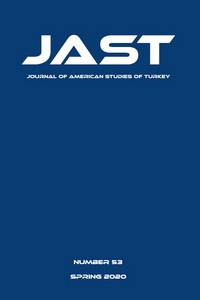Abstract
References
- Adler, Kathleen and Marcia Pointon. “The Body as Language.” The Body Imaged. Cambridge University Press, 1993, pp.125-128. Bampatzimopoulos, Sotirios. “Female Action Hero Vs Male Dominance: The Female Representation in Mad Max: Fury Road.” Ankara University: Journal of Languages and HistoryGeography, vol. 55, no. 2, 2015, pp. 205-218.
- Bakhtin, Mikhail. Rabelias and His World. Translated by Helene Iswolsky. Indiana University P., 1984.
- Chion, Michel. Film, A Sound Art. Translated by Claudia Gorbman. Columbia University P., 2009.
- Doane, Mary Ann. “Female Spectatorship and Machines of Projection: Caught and Rebecca.” The Desire to Desire: The Woman’s Film of the 1940s. Indiana University P., 1987, pp. 155-175.
- ---. “Film and the Masquerade: Theorizing the Female Spectator.” Femmes Fatales: Feminism, Film Theory, Psychoanalysis. Routledge, 1991, pp. 17-32.
- Gross, John. “Introduction.” The Oxford Book of Parodies, edited by John Gross, Oxford University P., 2010, pp. xi-xviii.
- Houseman, John. “How-and What-Does a Movie Communicate?” The Quarterly of Film Radio and Television, vol. 10, no. 3, 1956, pp. 227–238. JSTOR, www.jstor.org/stable/1209979. Accessed 1 March 2019.
- Love ’em and Leave ’em. Directed by Frank Tuttle, performances by Evelyn Brent, Lawrence Gray, and Louise Brooks, Paramount Picture, 1928.
- Mulvey, Laura. “Visual Pleasure and Narrative Cinema (1975)”. Visual and Other Pleasures. Palgrave, 1989, pp. 14-26.
- ---. “Fears, Fantasies and the Male Unconscious or ‘You Don’t Know What is Happening, Do You Mr. Jones?’ (1973)”. Visual and Other Pleasures. Palgrave, 1989, pp. 6-13.
- Raub, Patricia. “A New Woman or an Old-Fashioned Girl? The Portrayal of the Heroine in Popular Women’s Novels of the Twenties.” American Studies, vol. 35, no. 1, 1994, pp. 109– 130. JSTOR, www.jstor.org/stable/40642587. Accessed 8 March 2019.
- Riviere, Joan. “Womanliness as Masquerade”, International Journal of Psychoanalysis, vol. 10, 1929, pp. 303-313.
- Zeitz, Joshua. Flapper: A Madcap Story of Sex, Style, Celebrity and the Women who made America Modern. Three Rivers P., 2006.
Abstract
This article analyzes the objectification of the female
body, the function of the male gaze, and the construction of female
spectatorship in the American silent movie Love ‘em and Leave ‘em
(1926). Directed by Frank Tuttle, the movie features in the opening
credits a spectacle of a woman’s legs, in silky, transparent stockings,
and high-heeled shoes. This initial scene positions the attractive legs
of one of its female characters and prompts the question whether or
not the objectification of attractive female legs—in this case in almost
monumental proportions— deprives women of their subjectivity by
turning them into mere spectacles or commodities. However, it can
be argued that the critical stance the movie assumes is a parody of the
male gaze, rather than a simple presentation of stereotypical gender
roles. While reframing traditional gender norms in a performance of
parody, the movie also dismantles what critic Laura Mulvey calls a
“hermetically sealed world”, which plays on voyeuristic fantasies
of the spectator. Correspondingly, the movie takes a step further by
constructing a novel sphere for its spectators, in particular, female
spectators, where they could observe distinct representations of the
female body. Conjuring up a novel spectatorial sphere in which the
spectator views the female body through a critical light, Love ‘em
and Leave ‘em creates ruptures in phallocentric cinematic diegesis,
destabilizes the spectator’s expectations, and relocates their perception
in relation to multifarious questions it poses in scenes of parodies,
rather than serving male fantasies.
Keywords
Female Body Female Spectatorship Gender Roles Male Gaze Love ‘em and Leave ‘em American Silent Movie
References
- Adler, Kathleen and Marcia Pointon. “The Body as Language.” The Body Imaged. Cambridge University Press, 1993, pp.125-128. Bampatzimopoulos, Sotirios. “Female Action Hero Vs Male Dominance: The Female Representation in Mad Max: Fury Road.” Ankara University: Journal of Languages and HistoryGeography, vol. 55, no. 2, 2015, pp. 205-218.
- Bakhtin, Mikhail. Rabelias and His World. Translated by Helene Iswolsky. Indiana University P., 1984.
- Chion, Michel. Film, A Sound Art. Translated by Claudia Gorbman. Columbia University P., 2009.
- Doane, Mary Ann. “Female Spectatorship and Machines of Projection: Caught and Rebecca.” The Desire to Desire: The Woman’s Film of the 1940s. Indiana University P., 1987, pp. 155-175.
- ---. “Film and the Masquerade: Theorizing the Female Spectator.” Femmes Fatales: Feminism, Film Theory, Psychoanalysis. Routledge, 1991, pp. 17-32.
- Gross, John. “Introduction.” The Oxford Book of Parodies, edited by John Gross, Oxford University P., 2010, pp. xi-xviii.
- Houseman, John. “How-and What-Does a Movie Communicate?” The Quarterly of Film Radio and Television, vol. 10, no. 3, 1956, pp. 227–238. JSTOR, www.jstor.org/stable/1209979. Accessed 1 March 2019.
- Love ’em and Leave ’em. Directed by Frank Tuttle, performances by Evelyn Brent, Lawrence Gray, and Louise Brooks, Paramount Picture, 1928.
- Mulvey, Laura. “Visual Pleasure and Narrative Cinema (1975)”. Visual and Other Pleasures. Palgrave, 1989, pp. 14-26.
- ---. “Fears, Fantasies and the Male Unconscious or ‘You Don’t Know What is Happening, Do You Mr. Jones?’ (1973)”. Visual and Other Pleasures. Palgrave, 1989, pp. 6-13.
- Raub, Patricia. “A New Woman or an Old-Fashioned Girl? The Portrayal of the Heroine in Popular Women’s Novels of the Twenties.” American Studies, vol. 35, no. 1, 1994, pp. 109– 130. JSTOR, www.jstor.org/stable/40642587. Accessed 8 March 2019.
- Riviere, Joan. “Womanliness as Masquerade”, International Journal of Psychoanalysis, vol. 10, 1929, pp. 303-313.
- Zeitz, Joshua. Flapper: A Madcap Story of Sex, Style, Celebrity and the Women who made America Modern. Three Rivers P., 2006.
Details
| Primary Language | English |
|---|---|
| Subjects | North American Language, Literature and Culture, Literary Studies |
| Journal Section | Research Articles |
| Authors | |
| Publication Date | May 1, 2020 |
| Published in Issue | Year 2020 Issue: 53 |
JAST - Journal of American Studies of Turkey


